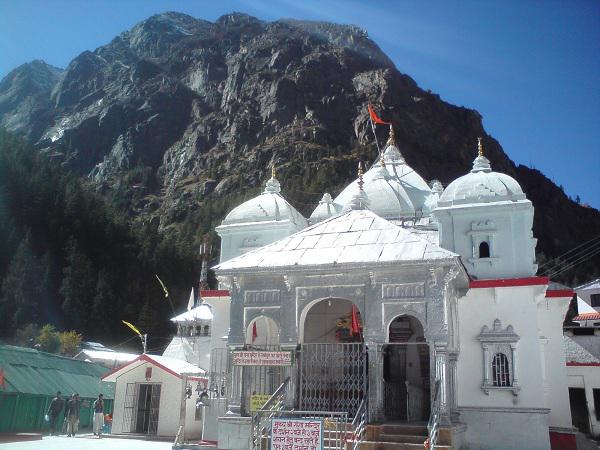The Gangotri Dham holds special importance for the Chardham Pilgrims. It is from that location that the sacred River Ganga emerged and reached the plains. One of the important shrines of the Chota Chardham pilgrimage circuit is Gangotri Dham. It seats atop the high Himalayas at the height of 3140 m. It remains inaccessible during the winter due to heavy snowfall. Only hermits and sages residing nearby stay put even during the rough weather.
During the Chardham pilgrimage visiting Gangotri Dham is a must for any devout Pilgrim whose heart is steeped in the desire to unite with God and bask in the divine aura of the ambiance. Also the location is dotted with numerous other religious places. To know more, read on-
History & Myth
The history, myth and legends overlap each other and everything seems true on this magical turf. Myth has it that Goddess Ganga in her fluid form was born out of Lord Vishnu’s big toe and stayed in the ‘kamandalu’ (water-pot carried by the hermits) of Lord Brahma. She used to flow from the water pot through the Heaven and was called ‘Swarg Ganga’.
Meanwhile, in the Satyug era, King Sagar had 60,000 sons who were quite barbaric in nature. King Sagar was performing Ashwmedh Yajna and as per custom the horse was let loose to wander off. If anybody stopped the horse it would mean challenging the authority. Chasing the horse, the princes found it grazing near Kapil Muni’s ashram tied to a tree (which was actually done by Lord Indra to disturb the meditating ascetic). The princes were infuriated as they took it as a challenge to them and began abusing Kapil Muni. The enraged hermit opened his eyes and reduced all the 60,000 princes to ashes. The princes sinned in accusing an innocent hermit of theft and therefore were not allowed in heaven. On knowing that goddess Ganga could relieve them of their sins, the successive descendants of the princes prayed but in vain. Ultimately, pleased by Bhagirath’s meditation to relieve his ancestors of grave sin, Goddess Ganga descended upon earth. She was initially not willing to descend upon the mortal world but requested by other gods and goddesses and by hard penance of Bhagirath she descended upon the locks of Lord Shiva as the earth is too fragile to hold the immense force of the heavy jet-stream.
Places to visit:
Gangotri Temple
Gangotri Dham
It is the place where it is believed that Goddess Ganga descended upon the matted locks of Shiva in the form of large jet stream. The present temple was built in 18th century by Amar Singh Thapa, a Gurkha commander and later renovated by Maharaja of Jaipur in 20th century. The temple throws open its portal on Akshay Tritiya which falls somewhat on last week of April or first week of May and closes down on Diwali. The 20 ft high shrine houses the idol of Goddess Ganga which attracts about millions of pilgrims round the year. The temple of Vishwanath and Kuteti Devi is also on the temple premise.
Here, on this stone platform Raja Bhagirath is said to have meditated for thousands of years praying to Goddess Ganga to descent upon earth and relieve the mortals of their sins. His penance ultimately pleased the Goddess and she descended upon earth.
Pandav Gufa
The mythical records state that the Pandavas meditated here on their way to Kailash to meet Lord Shiva. This place is 1.5 km upward trek from Gangotri towards Gaumukh Glacier.
Gauri Kund & Surya Kund
Surya Kund
About 500 m upwards from Gangotri Temple there is an iron bridge, on either side of which lie Gauri Kund and Surya Kund. The latter is specifically known for its waterfall.
Jalmagna Shivling
This naturally formed Shivling near the Gangotri temple can be seen only during winters when water level goes down. During summer, the Shivling remain immersed in the water. It is the place where Lord Shiva threw open his matted locks to receive Ganga on his head.
When to visit
The best time to visit is during the warm summers in May onwards when the weather is pleasant and dry. In the monsoons there are landslides and rolling rocks which cut it off from the outer world. After the rainy season, it gets cooler day by day and the winds are tolerably chilly till the snowfall during November afterwards.
Accommodation
There are many hotels and lodges for affordable stay. There are also a number of ashrams that provide good accommodation. GMVN Rest House provides budget stay for the tourists.
Author Bio
This guest post is submitted by Devendra Singh. Devendra Singh is a traveller who loves travelling around the World, mountaineering is his first love also love to reading books. Currently working with a leading travel company NamasteIndiaTrip.com that offers various tour packages for India and outbound.

